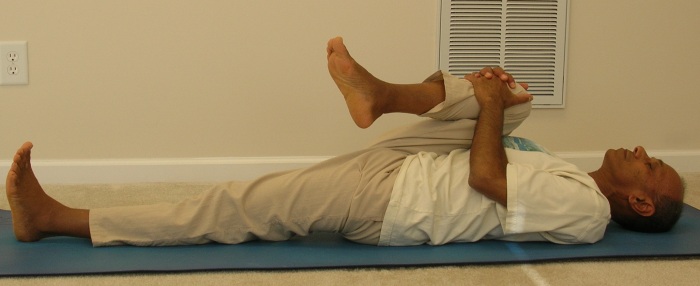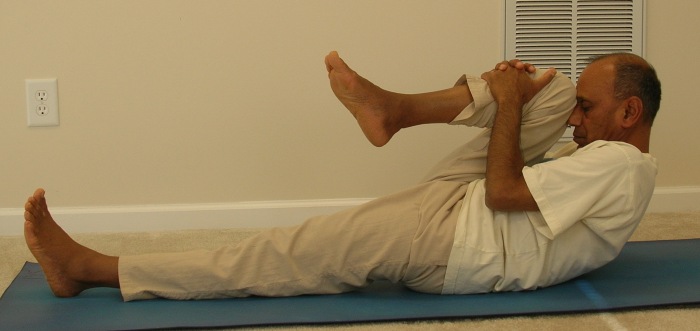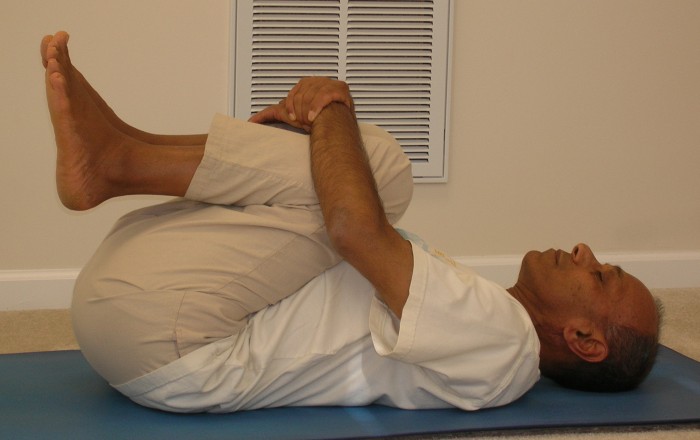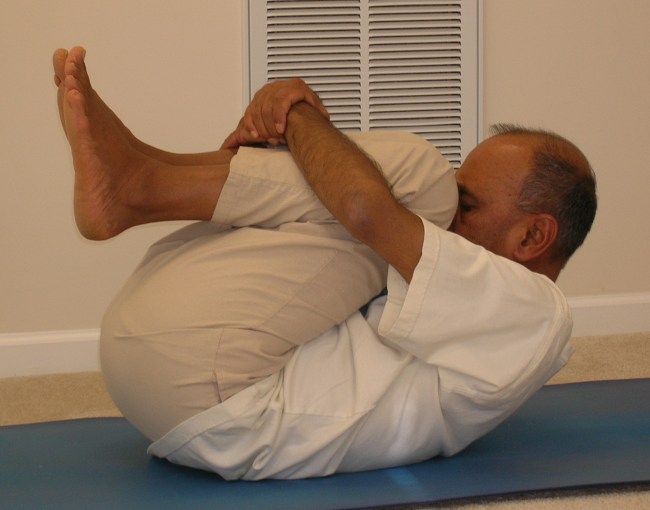
Pawana Muktasana
Pawana-muktasana (PMA) – पवनमुक्तासन – is a simple asana, easy to practice, and yet has many far-reaching benefits. It is a great pose for eliminating excess gases from the digestive tract, strengthening the core muscles, massaging the internal organs and giving relief to the lower back.
The name of the asana is a composite of two words – pawana means the wind or air and mukta means liberated or released. So, the common English translation for the pose is "Wind releasing pose".
Step-by-step
- Lie down on your back in Shavasana for a few breaths.
- Fold the right knee. Lifting the right foot up, hold the right shin with the two hands.
- While exhaling, gently begin to pull the knee toward the chest while at the same time lifting the head up. In a conscious effort to round the spine, try to close the gap between the raised knee and the forehead by lowering the chin down to the chest.
- Inhaling, lower the head down.
- Repeat steps 2, 3 and 4 for three more deep breaths.
- Relax in Shavasana for a couple of breaths.
- Repeat the above sequence with the other leg.
- Now fold both the knees. Lift the feet up and wrap the arms around the knees gently pulling the knees to the chest.
- Exhaling, begin to lift the head up. Again, in a conscious effort to round the spine, try to close the gap between the knees and the forehead by lowering the chin down to the chest.
- Inhaling, lower the head down.
- Repeat steps 8, 9, and 10 for three more breaths.
- Finally rest in shavasana
Variation 1 (breath retention after exhalation)

- Lie down on your back in Shavasana for a few breaths.
- Fold the right knee. Lifting the right foot up, hold the right shin with the two hands.
- While exhaling, gently begin to pull the knee while at the same time lifting the head up. In a conscious effort to round the spine, try to close the gap between the raised knee and the forehead by lowering the chin down to the chest.
- Remain in this position while holding the breath (kumbhaka) for a duration that is comfortable.
- Inhaling, lower the head down.
- Relax in Shavasana for a couple of breaths.
- Repeat the above sequence with the other leg.
- Now fold both the knees. Lift the feet up and wrap the arms around the knees gently pulling the knees to the chest.
- Exhaling, begin to lift the head up. Again, in a conscious effort to round the spine, try to close the gap between the knees and the forehead by lowering the chin down to the chest.
- Remain in this position while holding the breath (kumbhaka) for a duration that is comfortable.
- Inhaling, lower the head down.
- Finally rest in shavasana
Variation 2 (breath retention after inhalation)

- Lie down on your back in Shavasana for a few breaths.
- Fold the right knee. Lifting the right foot up, hold the right shin with the two hands.
- Take a long, deep inhalation. While holding the breath, gently begin to pull the knee while at the same time lifting the head up. In a conscious effort to round the spine, try to close the gap between the raised knee and the forehead by lowering the chin down to the chest.
- Remain in this position while holding the breath (kumbhaka) for a duration that is comfortable.
- Exhaling, lower the head down.
- Relax in Shavasana for a couple of breaths.
- Repeat the above sequence with the other leg.
- Relax in Shavasana for a couple of breaths.
- Now fold both the knees. Lift the feet up and wrap the arms around the knees gently pulling the knees to the chest.
- Take a long, deep inhalation. While holding the breath, begin to lift the head up. Again, in a conscious effort to round the spine, try to close the gap between the knees and the forehead by lowering the chin down to the chest.
- Remain in this position while holding the breath (kumbhaka) for a duration that is comfortable.
- Exhaling, lower the head down.
- Finally rest in shavasana
Benefits

- Pawana-muktasana expels the gases trapped in the digestive tract and the large intestines.
- It will help relieve the symptoms of indigestion, flatulence, stomach acidity, constipation, belching, and gases in the colon.
- Massages the whole back, improves the flexibility and blood supply to the entire spine.
- Stimulates kidney function.
- It massages the internal organs – liver, pancreas, intestines etc. and improves their function.
- Very helpful in strengthening the core muscles, flattening the stomach area.
- Enhances blood circulation in the hip joints.
- Brings about a healthy appetite.
Contraindications and precautions
- Avoid practicing Wind-Relieving Pose (Pawanmuktasana) if you are suffering from hyperacidity, hernia, slip disc, menstruation, neck and back problems, and during pregnancy.
- Use no force to bring the knees close to the chin.
- If you suffer from neck pain or lower back pain, do not lift the head up. Instead, keep the tail bone firmly on the ground and try to bring the knees close to the chest. This will provide great relief to the lower back.
- After PMA, a gentle sideways roll of the body will also provide relief to the spine.
[…] Boisvert of Engineered Adrenalin guides students in how to assume wind relieving pose. This gradual approach to yoga has been designed to provide ideal support for those who are […]
Respected sir, thank you very much for your wonderful articles. May I know the difference (in terms of benefits and contraindications) between these two, you mentioned: Variation 1 (breath retention after exhalation) and Variation 2 (breath retention after inhalation)
With regards,
Selvaraj.
Hello Selvaraj, besides the contraindications mentioned in the article, there are no others that I know of. The only caution you may observe is that sometime holding the breath after inhalation might make you uncomfortable. If that is the case, avoid that practice.